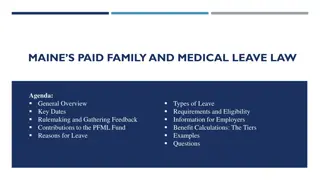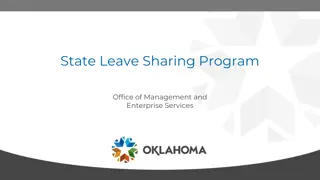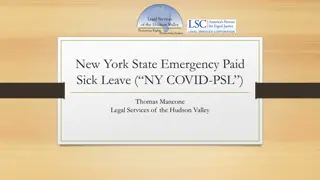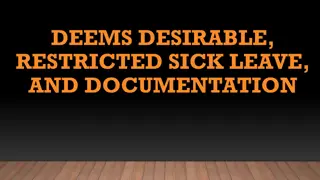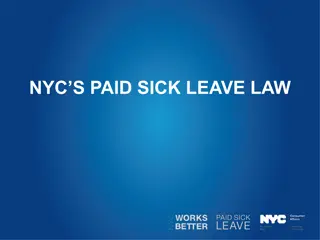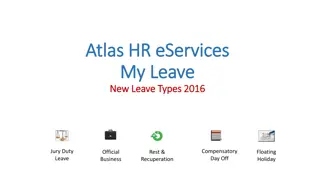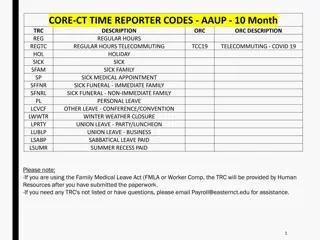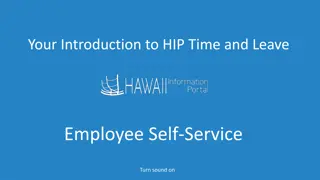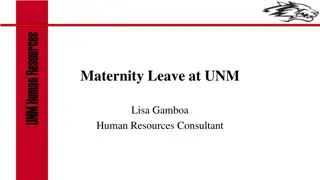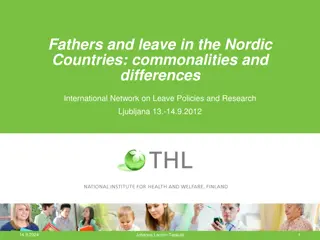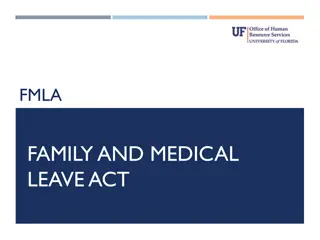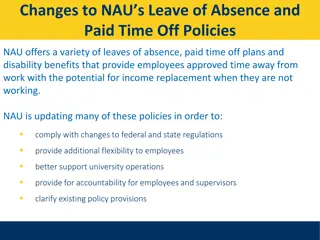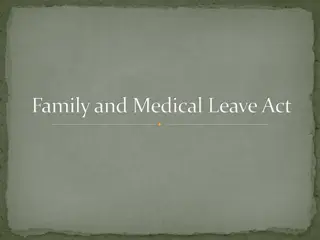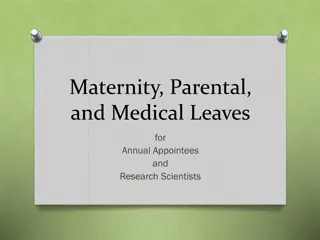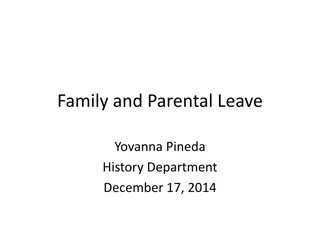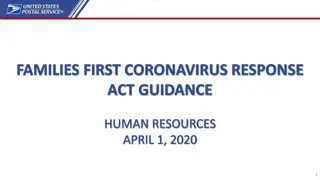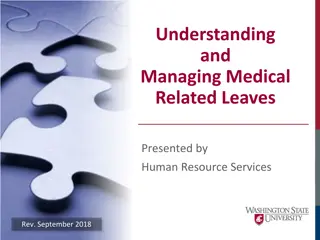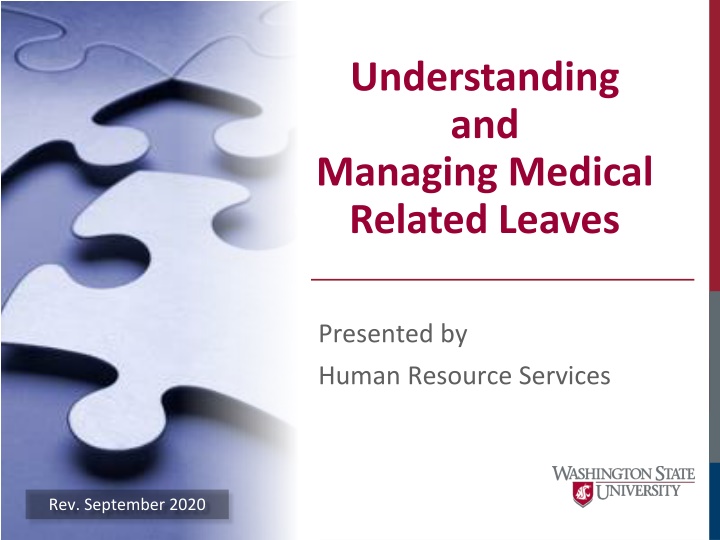
Managing Medical Leaves: Understanding Provisions and Benefits
Delve into the comprehensive guide on managing medical-related leaves, covering provisions such as Family Medical Leave Act, Disability Leave, and more. Learn about the interplay between different leave types, federal and state laws, and how to effectively utilize leave/time off policies.
Download Presentation

Please find below an Image/Link to download the presentation.
The content on the website is provided AS IS for your information and personal use only. It may not be sold, licensed, or shared on other websites without obtaining consent from the author. If you encounter any issues during the download, it is possible that the publisher has removed the file from their server.
You are allowed to download the files provided on this website for personal or commercial use, subject to the condition that they are used lawfully. All files are the property of their respective owners.
The content on the website is provided AS IS for your information and personal use only. It may not be sold, licensed, or shared on other websites without obtaining consent from the author.
E N D
Presentation Transcript
Understanding and Managing Medical Related Leaves Presented by Human Resource Services Rev. September 2020
Objectives How to manage medical related leaves Avoiding pitfalls
Leave of Absence Provisions Family Medical Leave Act Extended Leave - RA Family Care Leave Disability Leave Leave Types/Time Offs Annual Leave Sick Leave* Leave Without Pay (LWOP) Military Family Leave Family Leave Act - Parental Leave Domestic Violence Leave Compensatory Time Personal Holiday Shared Leave
Medical Leave Benefits provided according to Federal Law State Law (RCW) WAC/Collective Bargaining Agreements University Policy AP Handbook / Faculty Manual
Interplay between Leave Provisions and Leave Types Leaves of Absence Leave Types/ Time Offs Workers Comp. Family Medical Leave Act (FMLA) Leave Accruals Disability Leave Shared Leave Family Care Leave (FCL) Leave Without Pay (LWOP) Leave as a Reasonable Accommodation (RA)
Using Leave/Time Off General Rules Questions? Check the appropriate Policies Sample: BPPM 60.56 & 60.57
Family Medical Leave Federal Provision Job and Benefits protected leave 12 weeks/480 hours of leave, in a rolling 12 month period, for a full-time employee for qualifying event HRS determines eligibility
Family Medical Leave Qualifying Events: Employee s serious health condition Birth, adoption, or placement of a child (Parental Leave) Care for a qualifying family member (child, parent, spouse) with a serious health condition
Family Medical Leave Employee chooses how to use accrued leave or LWOP Leave can be for a block of time, reduced work schedule, or used intermittently All based on supporting medical documentation
Family Care Leave State Provision Care for an eligible family member Extends only as long as paid leave is available. Full-pay status required Eligible Family Members include: spouse, child, parent, parent-in-law, and grandparent
Domestic Violence Leave State Provision Allows victims of domestic violence, sexual assault, or stalking to take reasonable leave from work: To take care of legal or law enforcement needs and obtain health care Family members may take leave to help victim obtain help Paid or unpaid
Paid Sick Leave/Time Off Temporary Hourly Employees State Provision Temporary hourly employees begin accruing PSL on the first day of a new appointment PSL accrues at the rate of one hour for every 40 hours worked, including overtime hours Hours worked do not include PSL hours used Notice: Departments are required to provide Notice to employees no later than the first day of the appointment
Paid Sick Leave/Time Off Temporary Hourly Employees State Provision Usage: For own or family member s health condition When WSU has been closed by order of a public official for any health-related reason, or when an employee s child s school or place of care has been closed for such a reason For absences that qualify for leave under the domestic violence leave act Forward medical documentation to HRS
Disability Leave University Provision Non-FML eligible employees: FULL TIME leave for their own condition, up to total of 4 months FMLA eligible employees: Additional month of insurance benefits beyond FMLA period when an employee is out full time (4th month)
Medical Leave Requests Your responsibility as a supervisor is to: Identify a request, or potential need Sample notice triggers to refer employee to HRS: Verbal/written notice of need Employee calls out ill for over three days Employee was hospitalized Consistent use of sick leave or other leaves for sick reasons If your employee is approved for a medical leave through HRS, You will be notified.
Medical Leave Requests and Workday In Workday, all leave requests, including medical leave, will be electronic: Employees, supervisors, designated department time keepers and HRS Disability Services will be able to submit requests from any location If you are not sure if the event should be a leave of absence, contact HRS to begin the process
Medical Leave: To Say or Not to Say Say Ask them if time off is for FMLA event Not to Say Deny FMLA leave Ask what condition is, specifics Retaliation, off-hand comments Job impacting decisions against the employee based on FMLA
Leave Types/Time Offs Shared Leave RCW 41.04.660 BPPM 60.58 Allows state employees to donate their annual leave, sick leave, or personal holidays to another state employee who meets Shared Leave criteria.
Shared Leave CRITERIA Severe or extraordinary illness, injury, impairment, or physical or mental condition that is serious, extreme or life threatening (employee, relative or household member) Pregnancy disability or Parental leave
Shared Leave CRITERIA Victim of domestic violence, sexual assault, or stalking Called to Uniformed Services Employee is or is a spouse of person in Uniformed Services or is a veteran attending medical appointments Emergency volunteer service during state of emergency
Shared Leave PROGRAM Medical documentation and information must clearly reflect how condition meets criteria SHL usage eligibility timelines begin on the date the event meets the SHL criteria Must receive donations Limits to amount of leave per event ~Up to 90 days Lifetime maximum of 522 days full time employee
State of Washington Paid Family & Medical Leave Important Differences from Family Medical Leave Program administered by Employment Security Employees apply directly with ES online or via telephone Provides income replacement benefit, up to a maximum $1,000 per week* Important Similarities Provides similar job and benefit protections Supplemental Benefits Employees may use annual or sick leave, personal holiday, or compensatory time, as a supplemental benefit.
State of Washington Paid Family & Medical Leave Eligibility: 820 hours worked during the qualifying period (last 4 complete quarters for all Washington employers Minimum leave of 8 continuous hours, with a 7 day waiting period (except for birth or placement of child) Benefit Duration: Up to 12 weeks of Paid Family or Medical Leave Up to 16 weeks of Paid Family or Medical Leave (when multiple events) Additional 2 weeks for Pregnancy Complications
Long Term Disability Benefit for Extended Leaves Basic Plan $240/month after 90 day waiting period Available to all WSU employees Optional Plan Optional benefit plan employees purchase 90-360 day waiting period Benefit of up to 60% of salary, up to $10,000 per month after an employee selected waiting period Benefit administered by The Standard Insurance HRS coordinates the submission of documents and company communicates directly with employees
When a Workplace Injury Occurs Supervisor/Department Responsibilities Ensure first-aid and/or medical treatment is provided. If required - Call 911 Arrange for ride to hospital/doctor as necessary Have WSU Online Incident Report completed within 24 hrs. Refer to HRS DS
When and Incident Occurs Supervisor/Department Responsibilities Immediately report accidents which result in death, amputation, or serious injury according to policy (SPPM 2.24) Interview the injured worker and any witnesses ASAP
Workers Compensation Injury or Occupational Disease that has a . . . Proximate Cause which occurred during . . . Course of Employment or Volunteer work Overview of Coverage WA State Department of Labor & Industries (L&I) No fault insurance Priority is placed upon returning to work Medical care (100%)/ Wage replacement (60-75%)
Filing an L&I Claim If an employee chooses to file an L&I claim, they do so by contacting L&I through their medical provider, online, or over the phone. WSU may question the claim validity if: Not covered by law, nor work related, questionable based on situation etc. Notify HRS Disability Services immediately if concerns with incident
Workers Compensation and Leave/Time Off Claims paid through L&I, not WSU Employees use own accrued leaves/time off to maintain WSU pay Must have 8 hours of pay in a month to maintain benefits under FMLA and DL leave of absence provisions
Workers Compensation Coordination Do not change job duties due to illness or injury. Could potentially informally accommodate. Talk to HRS. If normal job is impacted by limitations, can the job be temporarily modified? Examples of Temporary Modified Duties: Part-time/alternate schedule New duties - same KSAs/Special projects Change building or location Different equipment or work methods
Reasonable Accommodations (RA) Disability - WSU will provide RA for a known physical, mental, or sensory limitation Pregnancy Related Accommodations Employee must be able to perform the essential functions of the position, with or without an RA
Not a Qualified Disability Non-chronic condition Sprain, broken limb, flu Current illegal drug use Active alcoholism or abuse
Types of Disability Accommodations Facility, work space modifications or location change Equipment purchase or modifications Work schedule modifications Extended leave (consistent with law) Reassignment to an open, vacant, recruited position
Pregnancy Related Accommodations If employee requests Does Not require medical documentation Longer, more frequent or flexible restroom breaks Modify a no-food or no-drink policy Provide seating or allow the employee to sit more frequently Limit lifting to 17 pounds or less
Pregnancy Related Accommodations If Employee requests Requires supporting medical documentation Job restructuring, including modifying a work schedule, job reassignment, changing a work station, or providing equipment Providing a temporary transfer to a less strenuous or hazardous position Scheduling flexibility for prenatal visits Additional accommodations based on need
RA Process Overview Identification - by the employee, the supervisor or a health care provider Documentation - medical certification normally required for disability accommodation and certain types of pregnancy accommodations Accommodation - HRS will work with the department and the employee to review the request and possible options
Undue Hardship Not based solely on departmental funds, it is more global No central funds for accommodations Light duty and/or extended medical leave are RARELY undue hardships
Department Responsibilities What to do Notify HRS of the possible need for leave or time off or RA Keep time off conversations private Be an active, constructive participant in the leave and RA processes Accommodate through the official RA process What Not to Do Do not informally accommodate Do not make job changes based on employee provided information regarding a medical condition without engaging HRS
Disability Services Coordination Long Term Disability RA Medical/Disability Leaves FMLA Interplay between these leaves is complicated. HRS is here to help you manage the process.
Resources BPPM 60.56 and 60.57 Leave BPPM 60.21 Reasonable Accommodation BPPM 60.58 Shared Leave BPPM 60.81 Volunteers BPPM 60.43 Paid Sick Leave for Temp/Hrly SPPM 2.24 Reporting Accidental Injuries Illnesses Administrative Handbook Faculty Manual Collective Bargaining Agreements Access Center - Student accommodations Civil Rights and Compliance Investigations (CRCI) EEO/AA compliance Disability discrimination WSU Accessibility - ADA Coordinator
Questions Human Resource Services Disability Services hrs.wsu.edu/Disability-Services 509-335-4521 or hrs@wsu.edu
This has been a Live Videoconference If you attended this live session from a location outside Pullman and wish to have your attendance documented in your training history, please notify Human Resource Services within 24 hours of today's date: hrstraining@wsu.edu

